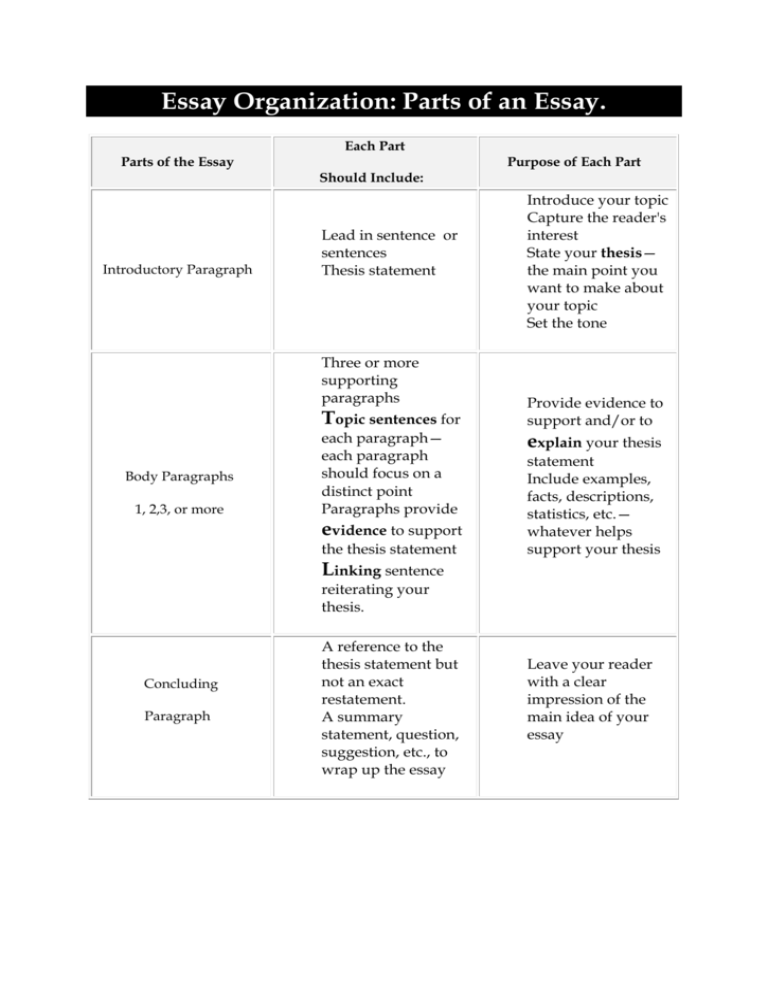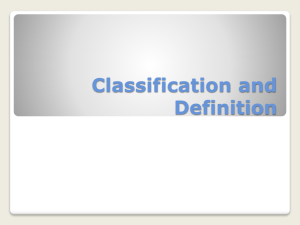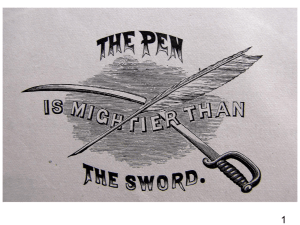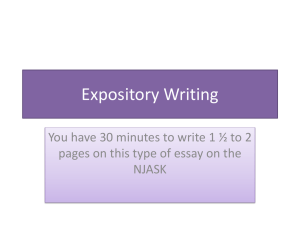Essay Organization
advertisement

Essay Organization: Parts of an Essay. Each Part Parts of the Essay Purpose of Each Part Should Include: Introductory Paragraph Lead in sentence or sentences Thesis statement Three or more supporting paragraphs Topic sentences for Body Paragraphs 1, 2,3, or more each paragraph— each paragraph should focus on a distinct point Paragraphs provide evidence to support the thesis statement Introduce your topic Capture the reader's interest State your thesis— the main point you want to make about your topic Set the tone Provide evidence to support and/or to explain your thesis statement Include examples, facts, descriptions, statistics, etc.— whatever helps support your thesis Linking sentence reiterating your thesis. Concluding Paragraph A reference to the thesis statement but not an exact restatement. A summary statement, question, suggestion, etc., to wrap up the essay Leave your reader with a clear impression of the main idea of your essay A closer look at body paragraph development -Each body paragraph must have a distinct, organized structure; a beginning, middle and end. –A precise and relatively short beginning and end, and a big chunk in the middle. e.g. Topic Sentence (Beginning) 1 2 3 Explanation/Evidence/Explanation (Middle) Linking Sentence (End) *Remember when we talked about making 2-3 points in each paragraph to support that paragraph’s overall contention? Here’s an even closer look at how to go about that: Topic Sentence (Beginning) 1 2 3 i -Indicate you are going to present one bit of evidence showing the topic sentence is true. ii -Introduce the first bit of evidence. iii -Present the first bit of evidence. iv –Explain the significance of the first bit of evidence. i - Indicate you are going to present the second bit of evidence showing the topic sentence is true. ii –Introduce the second bit of evidence. iii- Present the second bit of evidence. iv- Explain the significance of the second bit of evidence. i- Indicate you are going to present the third bit of evidence showing the topic sentence is true. ii – Indicate you are going to present the third bit of evidence. iii- Present the third bit of evidence. iv - Explain the significance of the first bit of evidence. Linking Sentence (End) **The most important thing to be mindful of is that you need to repeat this pattern in each body paragraph. Style and purpose Expository to inform or explain Persuasive to persuade or influence Forms Audience Language Essay Depends on context – usually educated adult readers. Authoritative, moderate; usually in third person. News story Newspaper/magazine readers Detached tone for objective account, third-person Research piece Readers with a special interest in the subject. Formal, serious, specialized vocabulary Personal letter One reader well known to the writer. Personal tone, descriptive. Depends on contextusually educated adult readers All newspaper readers Authoritative, moderate, third-person Essay Letter to the editor All newspaper readers Editorial Speech Opinion piece Imaginative to entertain; stimulate thoughts and feelings Any of the above forms when a fictional situation and/or persona is chosen Short story Play or film script Depends on context – usually listeners affected by the issue Readers with a special interest in the issue Various- depends on context and form selected Various- can be for children, young adult or adult or general mainstream audience (e.g. Hollywood cinema) Varies; tone is often personal, can use firstperson Objective, authoritative, formal; often uses inclusive language Clear, simple sentences and expressions to engage the audience Can use sarcasm, humour; tone can be moderate or highly emotive Various – depends on context and form selected Written in prose; describes characters and situations to draw in the reader Written as dialogue; some stage directions (play) or description of cinematography (film) Expository writing Expository writing explains or informs the reader about a particular topic. Expository writing can include narration, description, reasoning and definitions. It can be fictional or non-fictional. Forms of expository writing Types of expository writing include: Essays; analytical, informative, reflective. Newspaper and magazine reports, e.g. a news story Research articles, e.g. a paper presenting research findings and published in a journal Personal letters, e.g. to family or friends describing travels or explaining new circumstances Biographies and autobiographies Presenting a viewpoint: *If you are given a prompt, your main contention is your response to it. Expository writing puts a point of view without pressuring the reader to agree, but rather to consider. Incorporating ideas from a set text Compare and contrast ideas: if a text’s point of view is the same as (or different) from that of the prompt, explore similarities and/or differences in the body paragraphs of an essay. –You can choose to compare/contrast two different texts, historical events, characters etc. Focus on one key idea relevant to the prompt: show in two or more paragraphs how that idea is explored in the text as a whole. Explain how the text treats the idea to support your discussion of the prompt. Examine a key scene and/or characters: to show close knowledge of the text. Write one or two paragraphs explaining how an idea from the context is presented in this scene or by the characters. Expository writing in imaginative responses: A news report written from a location in the text A personal letter written by one character to another An editorial referring to circumstances in the text and commenting on a central idea. Let’s test drive this... Prompt: The future is one where people are denied full humanity by the restrictions imposed on their life. You have several options in approaching this task. Remember that you are not restricted to drawing on ideas solely from Gattaca. You may refer to other texts, history, facts etc to discuss your point. The idea is that you refer to each text/historical reference in its own paragraph. A kind of mix-and-match ordeal; 1. Comparing the ‘future worlds’ presented in 3 different texts to support your contention. e.g. Paragraph 1: Gattaca Paragraph 2: The Book Thief Paragraph 3: To Kill a Mockingbird. 2. Comparing three characters (all 3 from Gattaca, one from Gattaca/history/another text etc) 3. Comparing 3 different historical examples. e.g. P1: Nazi Germany P2: Australia; British Settlement P3: America: Civil Rights Paragraph #1: **Consider: How is this true in the world of Gattaca? E.g. The world of Gattaca is aiming to generate the perfect human race, a system which is flawed by that there exist valids and invalids. Although the valids are the elites and supposedly perfect and engineered to do whatever they please, they find themselves restricted just as the invalids are also. Invalids: Are restricted from fulfilling their dreams because society has labelled them as inadequate. Vincent is not genetically engineered. He is predicted or predestined to be restricted from achieving anything. He dreams about going into space but is told that the closest he will ever get to that spaceship is by cleaning the inside. Valids: Morrow (Jude Law) embodies perfection. He represents the model citizen/being. The problem with genetic engineering is that only the physical and intellectual qualities are enhanced. The emotions are not enhanced. It is emotions that make us humans and individuals. **Determination is also a human trait. So when a person is engineered to succeed no matter what, there’s no point in trying, dreaming, aiming. The engineered being is turned into a machine. They do things because that’s how they are wired. Invalids (Vincent) still have that drive, they still dream and make an effort. They have personality. The determination makes them able to go further; Vincent: “My heart is 30,000 beats overdue.” Valids are also restricted in their own way; they do not feel much, or cannot deal with emotions. They are bland, personality wise. Eugene Morrow commits suicide when, even in his perfection, he fails (comes second in the race) Paragraph #2: How is the prompt true to the ‘future’ beheld by New Australians after 1901 Federation with the WAP and Assimilation Laws passed? Reference to history: 1901- Federation. Australia comes together as one nation. In its debut as a nation, the future was bright for Australia; it was quick to establish its national identity which was restrictive in itself, stripping the population of its humanity in various ways. -The White Australia Policy restricted the future of the new Australian culture and population by determining who could enter the country based on their race (genes!!? Hence the parallel to Gattaca). **Dictation tests were set in foreign languages so that people would not pass them and be granted access into the country. Assimilation/Integration laws were passed which forced non-English speaking migrants (Italians, Greeks, Polish etc) to be something that they are not. Consider how many cultures were lost, how many languages, identities etc. *Research the extent of the racism that took place in the mid-20th Century in Australia. Paragraph #3: British Colonisation. Britain was once an empire that extended its boundaries by colonising ‘unclaimed’ territory. Upon finding Indigenous on the various lands they colonised, they took it upon themselves to invite these “savages” into the future by ‘civilizing’ them. Consider the treatment of the Aborigines and the Stolen Generation. How were they restricted by the self acclaimed superior race? How were they stripped of their humanity? Note: Refer to previous essay structure notes for assistance with formulating/structuring your introduction and conclusion.






